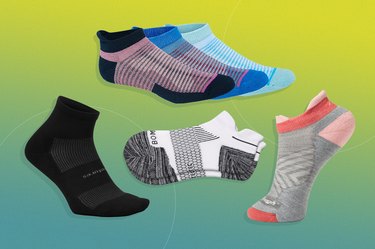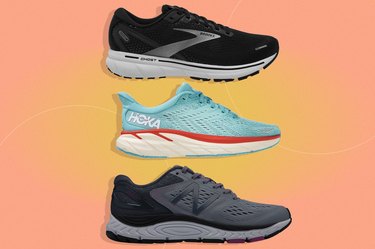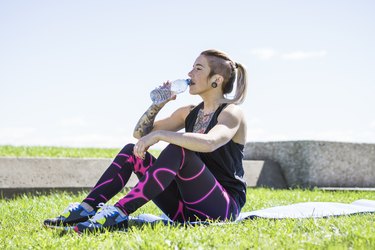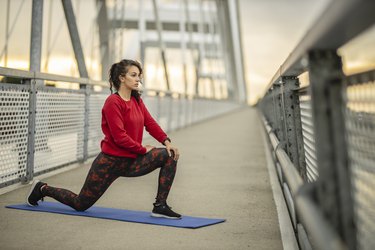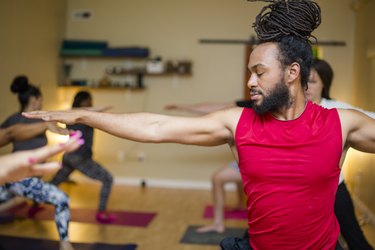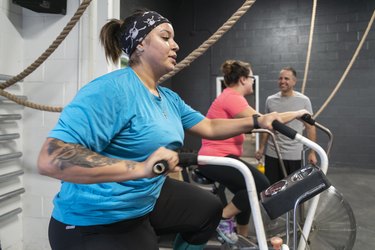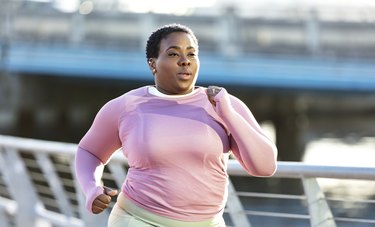
Running is an extremely popular form of exercise, for good reason. It's fun, requires minimal equipment and can be done pretty much anywhere. But people with overweight and obesity may feel their body size prevents them from getting started with running.
In reality, runners come in all shapes and sizes. With the right attitude, gear, strategy and support system, people in larger bodies can enjoy the many benefits of becoming a lifelong runner.
Video of the Day
Video of the Day
We spoke with three certified running coaches who work with folks with overweight and obesity. They shared their top 10 tips for getting started, staying healthy and improving your running performance.
A Quick Language Note
We make deliberate choices about the language we use when it comes to body size. We use person-first language, such as "people with overweight" and "people with obesity," rather than "overweight person" or "obese person."
Using this terminology as it relates to body size is considered neutral, nonjudgmental and based in physiology — not stigma — which means it's more inclusive, hopeful and helpful, according to the American Diabetes Association.
1. Talk to Your Doctor
It's always a good idea to speak with your doctor before embarking on any new exercise program. This is especially important if you have a history of heart, lung or joint conditions. If you are returning to exercise after an injury or surgery, you should also make sure you are cleared for the specific type of training you plan to do.
2. Take the Leap
Lots of people feel apprehensive at the start of their running journeys. Folks with overweight and obesity may be particularly concerned because of all the messages they've received about running in larger bodies in the past.
Running coaches hear this all the time and encourage you to just get started in the ways you can handle right now.
"Starting any new journey can be nerve wracking," Michelle Stratton, CSCS, owner and head coach of sTRIve Performance, tells LIVESTRONG.com. "Break it down into manageable, less intimidating segments."
You might need to take a leap if you're feeling afraid at the start of your running journey, Martinus Evans, certified running coach and owner of Slow AF Run Club, says.
"Take small steps and celebrate those wins — even if that's just running to the first light pole or your mailbox," he tells LIVESTRONG.com.
Evans reminds new runners that it doesn't matter where they are starting out and encourages them to focus instead on where they're going.
Related Reading
3. Get the Right Gear
The most important piece of gear you need as a new runner is a good pair of shoes.
"Don't try to use any old sneaker," says Janet Hamilton, CSCS, owner and lead coach at Running Strong. "Make the investment in a good running shoe and be willing to replace it when it shows signs of wear." (Start your search with our own list of best running shoes!)
The support and cushioning in your shoes will gradually wear down through use and time. Although the standard recommendation is to replace your shoes every 300 to 500 miles you run, Hamilton says folks in larger bodies or those who regularly run on hard surfaces, such as asphalt or concrete, may need to replace shoes more frequently.
"A good shoe won't make you an elite runner, but a bad fitting shoe can cause all types of heartache, like missing toenails, blisters and knee pain," Evans says.
All new runners should visit a speciality running store to be fitted for their first pair of running shoes, he suggests. These stores will do a gait analysis where they watch the way you walk or run and look at the bottoms of your current shoes to determine what shoes will be the best fit for you.
Next, you'll need the right clothes for your runs. Stratton says it's important to find clothes that make you feel comfortable. She suggests looking for moisture-wicking material and avoiding seams in high-friction areas to help reduce the chance of chafing.
Hamilton seconds the need for moisture-wicking clothing that fits your body.
"For women, it's important to wear a supportive sports bra. Shop around until you find one that fits well and supports properly," she says. "For persons with larger thighs, it sometimes helps to wear a lycra-based short or capri to minimize thigh chafing."
If you feel self-conscious going this route, she suggests wearing a pair of loose-fitting shorts over top.
Buy your initial running gear at an affordable price, Evans recommends.
"You want to make sure you're really committed before spending a lot of money on clothes," he says.
He suggests purchasing more expensive running gear from name brands as a reward for hitting your training or competition goals.
Use runners lube to provide additional protection against chafing, Hamilton, Stratton and Evans suggest. There are many such products on the market that can help keep you comfortable on your runs.
Not Sure Where to Start? Shop Our Favorite Gear Picks
4. Start With Walking
You've heard that you have to run before you can walk, and that's especially important for folks in larger bodies who are just getting started with their running journeys. Walking helps prepare your body to eventually absorb the impact of running to decrease your risk of injuries.
"People who aren't currently running shouldn't just jump into a full running program," Hamilton says. "You might have the aerobic capacity to sustain a 2- to 3-mile run, but other systems in the body may not be ready."
It's crucial to first build a foundation of walking to build up the muscle, bone, ligament and tendon strength you'll need for running.
Work up to a walking program covering 10 to 12 miles per week for at least a month before you begin adding running to the mix, Hamilton suggests. Taking this approach allows you to slowly build consistency while giving your body time to adapt.
Beginner Walking Workouts to Try
5. Gradually Transition into Running
Once you've built up a solid foundation of walking, you can transition into running, using a walk-run combination when you're getting started, according to Stratton, Evans and Hamilton. This is a method where you alternate between periods of running followed by periods of walking.
You should begin with walking periods that are longer than your running periods (1 minute of running and 5 minutes of walking, for example), Stratton says. As time goes on, the running periods will get longer and the walking periods will get shorter. Soon you'll be matching your run-walk periods or even running for longer (5 minutes of running and 1 minute of walking).
After several weeks or months of slow progression, you may feel ready for a full-blown run. However, don't be in a hurry to get to the next stage too quickly.
"You should feel like you are comfortable and in control at each stage of the game," Hamilton says. "If you have to hold at a certain walk-run ratio for several weeks to accomplish a sense of comfort with it, then hold steady until you do!"
Every runner will progress at their own pace and it's important not to force anything.
Prioritize consistency and frequency first when setting up your weekly running plan. This means it's better to do shorter sessions more frequently as opposed to doing long sessions once or twice per week.
You can begin with around 20 minutes of walk-run, 3 to 4 times per week, according to Stratton. You can gradually increase the time by 5 to 10 minutes every few weeks along with manipulating your walk-run intervals.
Another approach, used by Hamilton, is to alternate between overload and recovery days. You will do longer sessions on some days and shorter sessions on other days. This system allows you to push yourself while still providing plenty of time for rest and recovery.
What about how fast you run? Evans says this should be the last thing you worry about.
"Training to run faster too soon is one of the quickest ways to get injured," he says.
Instead, he suggests focusing first on distance and consistency. The more you run, the more efficient you become. This will naturally lead to increases in speed.
Beginner Running Workouts to Try
6. Pay Attention to Your Running Form
Running is a skilled movement just like playing a sport or performing a strength-training exercise at the gym. This means form and technique are important if you want to move well, feel good and achieve your personal goals.
Begin with a tall, relaxed posture. Keep your chest up and look to the horizon. As you run, you should lean forward slightly. Stratton says leaning backward puts unnecessary strain on your lower back, which could lead to discomfort or pain. Evans suggests you find the right amount of forward lean for your body by running in place and experimenting with different body angles.
Always aim to stay loose when you run. Avoid shrugging or tightening your shoulders and keep your hands relaxed. Evans uses an analogy of holding a pebble: Imagine you're loosely holding a pebble in your hands without gripping it tightly or letting it drop to the ground.
Your center of mass should stay beneath you as you run. This means your feet should strike the ground beneath you, not way out in front of you.
"Overstriding puts extra tension on the joints of the ankle and knee, and it also serves as a braking mechanism," Stratton says. "To avoid this, shorten your stride length and keep your turnover and cadence high and light."
If you're having trouble with your running cadence, use music to help you find your rhythm. Hamilton suggests finding songs with an 80- to 90-beat-per-minute tempo. The same foot should always strike the ground in time with the beat.
Related Reading
7. Make Strength Training and Stretching Part of Your Routine
Running places high external forces upon your body. Building physical strength puts you in a better position to absorb these forces so you can continue training without being sidelined by injuries. This is especially important for folks with overweight and obesity, who are already at a higher risk of developing joint diseases, like osteoarthritis.
The most important muscle groups for runners to target in the weight room are the lower body and core. Building strength in these areas supports the muscles and joints used during running. Stratton says stronger leg and core muscles also improve running gait, form and posture.
It's important to train your entire lower body. Many popular lower-body exercises, such as squats, lunges and hip thrusts, heavily bias the quads and glutes. Although these muscles are important to your running success, it's equally important to target your hamstrings and calves. Single-leg exercises are also highly beneficial because you will only ever have one leg in contact with the ground at any given time while running.
Core training is also important because you use your core to maintain proper posture as you run. Your core helps stabilize your pelvis and spine as you move. It also transfers force between your lower body and upper body, and vice versa. A strong core will help you run with good form, and it may reduce the risks of injury, aches and pains.
Some of the exercises recommended by Stratton, Evans and Hamilton include:
Include one or two strength-training sessions in your weekly routine for best results. Prioritize getting stronger in the 6- to 10-rep range. Although lower-body and core training should be your main focus, it's a good idea to train your upper body as well. Exercises such as elevated push-ups and TRX inverted rows are a great place to start.
Working on your mobility and flexibility can also help you stay healthy as you increase your running mileage. Stretches that target your glutes, hips, hamstrings, quads and calves can be beneficial.
Mobility drills to open up your hips, shoulders and ankles are also a staple of many running programs. You can perform these drills as a warm-up or cooldown before or after running or strength- training sessions. You can also perform them on their own throughout the workday to break up long periods of sitting.
8. Consider Doing Some Cross-Training
Cross-training is any type of training that isn't running, and it's important to continue getting stronger and improving your endurance while giving your body a break from the ground impact forces of running. Stratton suggests doing one cross-training session a week, if possible when you're starting out.
If you have access to a pool, swimming or water running are both fantastic options to complement your run training. Water-based exercise is very low-impact and feels great on your joints. Cycling is another low-impact option that helps build your aerobic fitness. Yoga is also a great cross-training option to help stretch out after lots of running, Evans says.
Keep in mind there will be a learning curve with cross-training activities just like there is with running. Don't assume you'll be a great cyclist or swimmer just because you're a runner. Be patient with yourself and reach out to a coach for guidance as needed.
9. Listen to Your Body
One of the best ways to avoid injuries while running is to pay close attention to your body; don't ignore small warning signs that something could be wrong. It's easy to shrug things off when they're only minor annoyances, but doing so could lead to a host of problems and potentially sideline you from running down the road.
"Listen to the 'whispers' of your body — the little sense that something is a little sore, or stiff, or signs of excessive fatigue fall into this category — that way it doesn't have to 'shout' at you. Injuries like shin splints, knee pain, plantar fasciitis, etc. fall into this category," Hamilton says.
Taking your time and progressing slowly can help avoid these problems. And, if you're returning to running after some time away due to an injury, it's doubly important to ease into things. Many people who repeatedly get injured keep repeating the same mistakes by trying to go at their training too aggressively, Hamilton says.
10. Enjoy the Journey!
Becoming a runner is so much more than just hitting the pavement. As you're taking your time to slowly build up your strength, stamina and endurance, be sure to take time to appreciate yourself and your hard work. Small celebrations along the way make it much more likely you'll actually stick with running for the long term.
Setting personal goals is a great way to stay motivated and give your training direction. Your initial goals may include staying consistent or slowly increasing your training distance each week.
But as you get more miles under your belt, consider entering a 5K or 10K race. You can eventually set your sights on more ambitious goals like running a half-marathon or marathon. Just make sure you leave yourself plenty of time to train so you are able to enjoy the big event.
Evans also emphasizes the importance of finding community.
"Community can be the difference between stopping running when things get hard or running for the rest of your life," Evans says.
New runners may have a hard time finding support among close friends or family. If that's the case, consider finding an in-person or virtual running group. You can even seek out groups specifically geared toward runners in larger bodies, like Slow AF Run Club. (You can also check out our list of tips for finding a run club that fits your needs!)



